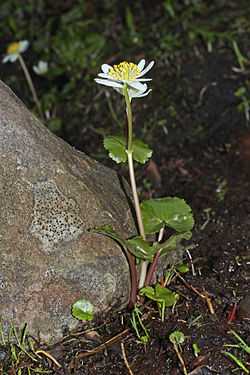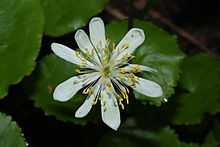Caltha leptosepala
| Caltha leptosepala | |
|---|---|
 | |
| Caltha leptosepala subsp. howellii | |
| Scientific classification | |
| Kingdom: | Plantae |
| (unranked): | Angiosperms |
| (unranked): | Eudicots |
| Order: | Ranunculales |
| Family: | Ranunculaceae |
| Genus: | Caltha |
| Species: | C. leptosepala |
| Binomial name | |
| Caltha leptosepala DC. | |
Caltha leptosepala (White Marsh Marigold, Twinflowered Marsh Marigold, or Broadleaved Marsh Marigold) is a species of flowering plant in the buttercup family. It is native to western North America from Alaska to New Mexico, where it grows in wet mountain habitats in alpine and subalpine regions. There are two general wild types of this species, one native to the interior and one that grows along the Pacific coast and coastal mountains, but these are not always treated separately.[1]

This is a perennial herb growing a mostly naked stem with leaves located basally. The leaves are up to 13 or 15 centimeters long and may have smooth, wrinkled, or toothed edges. The inflorescence bears one or more flowers. Each flower is 1 to 4 centimeters wide and lacks petals, having instead petallike sepals which are usually white or sometimes yellow. In the center are many long, flat stamens and fewer pistils.
| Wikimedia Commons has media related to Caltha leptosepala. |
External links
- USDA Plants Profile
- Edibility of Caltha leptosepala: Visual identification and edible parts of Caltha leptosepala.